| |||||||
| Search Forums |
| Advanced Search |
| Go to Page... |
 |
| Search this Thread |  1,188,711 views |
| | #1 |
| Team-BHP Support  Join Date: Feb 2004 Location: Bombay
Posts: 24,198
Thanked: 36,139 Times
| Renault Duster AWD : Official Review The Renault Duster AWD has been launched in India at a price of between Rs. 11.89 - 12.99 Lakhs (ex-Delhi). What you’ll like: • Robust, abuse-friendly build & construction • A very competent softroader. AWD system can take you places no 2WD can • Retuned 109 BHP engine & shorter gear ratios make the Duster AWD extremely driveable • 1.5L dCi turbo-diesel is known for its consistently high fuel efficiency • Outstanding ride quality has further improved. Comfortable over any kind of road • Car-like to drive. Balanced handling and dynamics. Extremely stable at high speeds • Safety kit: ESP, ASR, ABS, EBD, BA & understeer control. Dual airbags for the top variant • 210 mm of ground clearance for the AWD version. Dismisses broken roads with aplomb What you won’t: • Not a hardcore offroader like the Jeep & Gypsy 4x4s • No 3rd row of seats. The Scorpio & Safari Storme are 7-seaters • Interiors look cheap & dated in many areas. Weird ergonomics as well • Mediocre rear seat legroom. More like C1 segment sedans than C2 • Poor NVH insulation. Engine, road & wind noise are prominent inside the cabin • Missing features: No climate control, 60:40 splitting rear seat, dead pedal or 1-touch down windows • Bigger, more spacious & feature-packed XUV500 AWD isn't priced too far above • Renault's after-sales service quality is inconsistent The 2016 Facelift & Automatic: • Link to Review The 2020 1.3L Turbo Petrol: • Link to Review This review has been jointly compiled with Tejas@perioimpl. Thanks to him for the expert observations & comments! 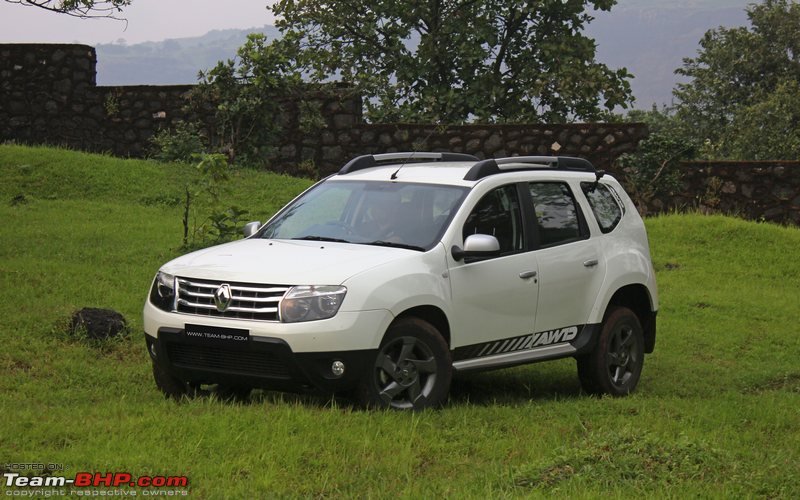 Last edited by Aditya : 30th September 2020 at 20:41. Reason: Link to 1.3L Turbo Petrol Review |
| |  (41)
Thanks (41)
Thanks
|
| The following 41 BHPians Thank Rehaan for this useful post: | aah78, Aditya, anilntny, dean5545, dhanushmenon, ecosport rules, Equus, fusionbang, Gannu_1, Grr7, GTO, haisaikat, hmansari, InControl, kevintomin, MaheshY1, Mighty_Lothar, Nash007, paragsachania, Puffdamgcdragon, RavenAvi, rednikhil, Reinhard, Rigid Rotor, rshanker, ruzbehxyz, S2!!!, samabhi, sandeepmohan, scopriobharath, sdp1975, Sheel, Simple_car, SmartCat, speed kills, swiftnfurious, Technocrat, Tejas@perioimpl, theexperthand, vb-saan, yosbert |
| |
| | #2 |
| Team-BHP Support  Join Date: Feb 2004 Location: Bombay
Posts: 24,198
Thanked: 36,139 Times
| Links to the Duster Review Since the Renault Duster has already been reviewed by Team-BHP, this report will only focus on changes made to the AWD variant. For easy reference, here are direct links to the complete Renault Duster road-test: Exterior Design & Build Quality Interior design, space, practicality & features Engine, gearbox, suspension & on-road behaviour Other Pertinent Points The Smaller yet Significant Things Last edited by GTO : 17th October 2014 at 18:37. |
| |  (21)
Thanks (21)
Thanks
|
| The following 21 BHPians Thank Rehaan for this useful post: | chiranjitp, Gannu_1, Grr7, GTO, hmansari, Insearch, MaheshY1, Nash007, noopster, phamilyman, RavenAvi, S2!!!, samabhi, Simple_car, swiftnfurious, Technocrat, Tejas@perioimpl, theexperthand, vb-saan, Wanderers, yosbert |
| | #3 |
| Team-BHP Support  Join Date: Feb 2004 Location: Bombay
Posts: 24,198
Thanked: 36,139 Times
| Exterior So, what's new on the outside?  The Duster AWD gets small cosmetic changes, though it otherwise remains physically identical to the 2WD:  The overall package looks smarter and more current than the 2WD, due to the minor tweaks pointed out below:  'Smoked' finish on the headlamps (black surrounds instead of chrome) is the only change at the front:  Structurally, the twin barrel headlamp layout is identical to the 2WD: 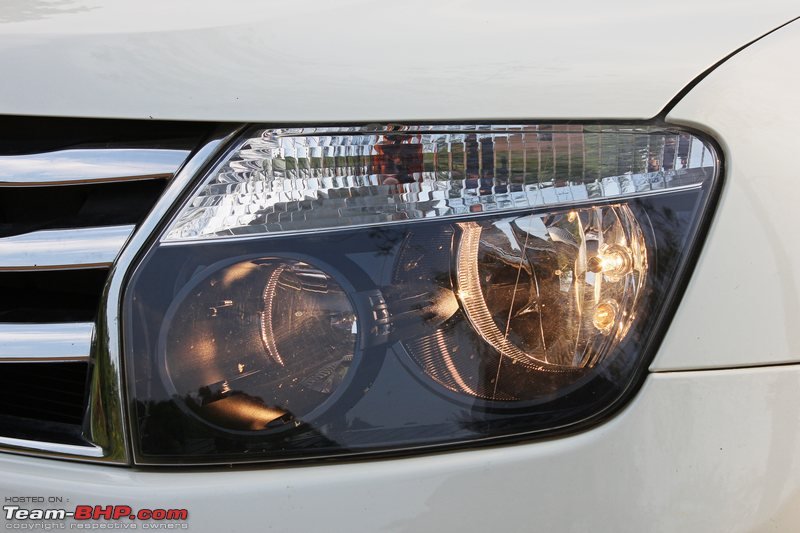 'Anthracite' finish on the wheels makes the outdated alloy design look more with-the-times:  AWD gets blackened B-pillars:  AWD stickering is liked by most. However, it has already begun to shred & peel!! These stickers aren't going to last too long:  Cool placement & shape of this AWD sticker. Look closely...this one is peeling too! AWD owners, consider a clear plastic overcoat:  The rear stays virtually the same as its 2WD sibling:  The tail-lights haven't changed at all. "Rapid Deceleration Warning" is now built in. They strobe under emergency braking:  4WD badge has been added at the back: 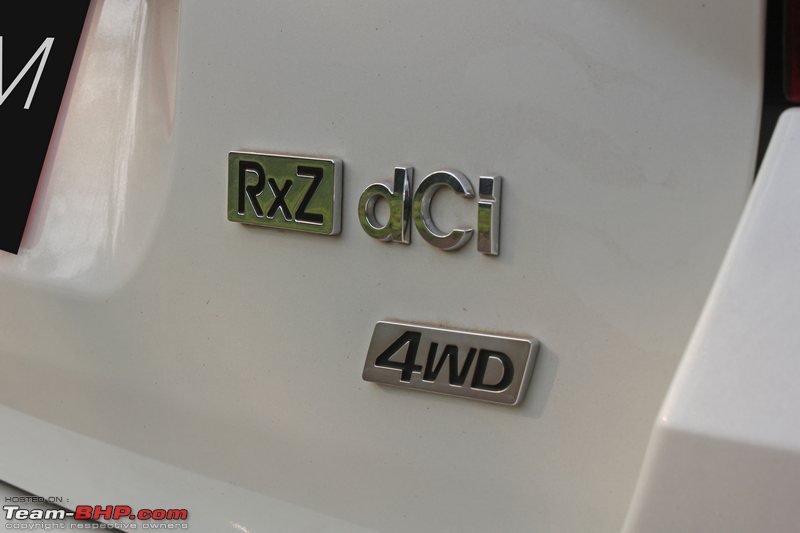 Dusters have only 3 parking sensors, while most other cars get 4. On the thick chrome strip is a button to open the rear hatch (it's not a reverse camera):  This large exhaust chrome tip could hamper the extreme end of the departure angle range. Tow hooks at the front & rear are permanently exposed:  Ground clearance has gone up from 205 to 210 mm for the AWD   The Duster AWD has 6 colour options: White, Black, Brown, Grey, Silver and Amazon Green. The Red of the 2WD isn't available on the AWD:  Note the difference between the AWD's smoked headlamps (left) and the regular headlamps on the right:  Observe closely, and the different rear suspension setups are quite evident:  A look under the Duster AWD shows its independent suspension at the rear. This improves the already awesome ride quality of the Duster:  A rough gauge of the AWD's ground clearance (albeit between the rear wheels). AWD's exhaust hangs lower and could take hits:  This is the 2WD Duster. Notice the torsion beam rear suspension, under-hung spare tyre and higher routing of the exhaust:  Last edited by Rehaan : 17th October 2014 at 17:46. |
| |  (36)
Thanks (36)
Thanks
|
| The following 36 BHPians Thank Rehaan for this useful post: | .anshuman, aah78, Aditya, ampere, Batfreak, Chethan B G, frankmehta, Gannu_1, GTO, hmansari, InControl, lurker, MaheshY1, mallumowgli, Mighty_Lothar, noopster, RavenAvi, rednikhil, Rigid Rotor, rshanker, S2!!!, samabhi, scopriobharath, Sheel, Simhi, Simple_car, SmartCat, swiftnfurious, Technocrat, Tejas@perioimpl, theexperthand, thoma, TOINGPOING, uday.ere, vb-saan, yosbert |
| | #4 |
| Team-BHP Support  Join Date: Feb 2004 Location: Bombay
Posts: 24,198
Thanked: 36,139 Times
| Interior So, what's new on the inside?  While the Duster AWD's interiors are nearly identical to the 2WD variant, there are a few notable changes. Namely, the different interior & dashboard colours, a new steering wheel & instrument cluster design, updated seat upholstery, reduced boot space and some changes to the switchgear. Renault has also introduced a "MediaNav" system which is standard on the top-end AWD variant (available as an option on the 2WD). Let's start with the dashboard. Instead of the 2WD's black dash & beige coloured inlay, the AWD gets a black dash with a light grey inlay. While the black plastic looks decent, and is slightly soft-touch too, the grey inlay is rock hard. The black-grey combination looks good in pictures, but in person, the grey colour tone looks faded and cheap. It has a wood-grain like texture on it that doesn't really suit the car, and the feel of the plastic isn't great either. The AWD's center console gets a silver trim surrounding it (2WD has a piano black trim). This helps liven up the dashboard a little. The steering has been redesigned to look more contemporary, although the new cruise control buttons look like they are out of the '90s. Note that the Duster has always had audio controls mounted on a short stalk just behind the steering wheel...a trend that continues with the AWD. The steering is leather wrapped, with a textured rubber inset on the bottom half. The leather is firm and the surface is very grippy. Tejas felt that the rim of the steering wheel is on the thinner side, yet I found no reason to complain. The cruise control buttons have resulted in the horn pad getting a bit smaller; it's still extremely usable. A press anywhere on the pad gets the horn to oblige willingly. It's not a macho sounding horn, yet a fairly loud one. Due to the positioning of the buttons, drivers with larger hands might feel like their palms cover the steering controls when the wheel is held at the suggested 9 o'clock & 3 o'clock position. The steering wheel has a good range of rake adjust. Taller drivers who slide their seat all the way back will miss the adjustable reach feature. The redesigned instrument cluster is an improvement in all respects. It's comprised of 3 chrome-lipped dials, one of which houses a large MID readout. The new MID display shows information such as liters of diesel consumed for the current trip, average & real-time fuel consumption, distance-to-empty, odometer, service interval, tripmeter, trip average speed and outside temperature. The speedometer and tachometer needles have a unique backlit yellow. This instrument cluster design looks a lot more 3-dimensional and modern in comparison to that of the 2WD Duster. The light & wiper stalks have been redesigned, and a one-touch lane change function has been added too. While the stalks look nice and well put together, they do have a plasticky feel. The rotary switches work smoothly. However, a major downside is that moving the stalks up & down or back & forth isn't smooth or refined. For example, it takes too much force to activate the turn indicators at times. Even flashing the high-beam requires a firm tug to overcome what feels like jammed plastic joints. The quality and operation here is inconsistent. Despite the Duster looking exceptionally wide from the outside, the interior doesn't follow suit. In the first 30 minutes, Tejas and I bumped our elbows and arms together several times. Having a usable center armrest would have been nice. Ergonomically too, there are a few issues. The 4WD dial is very out of the way; the driver has to lean forward and stretch just to reach it. It's the same with the ECO mode and ESP buttons which are located right beside it (just ahead of the gear lever). On the flip side, the central locking button gets more user friendly, as it is now a single toggle button (vs. the earlier lock / unlock type). What really jumps out as el cheapo looking are those small rectangular plastic patches on the door pads, where the window switches should have been. We're not sure if these are caps for screws, or covers for an alternate window switch position - either way, they really look cheap. The padded black fabric with white stitching feels nice on the door pads. However, that's pretty much the only thing that stands out as high quality here. The ledge you rest your arm on is rock hard. One can easily spot exposed screws in other locations (e.g. cupholder behind the handbrake, interior door handle mounts etc.). Exposed seat rails are very visible at the front as well, especially if the seats are moved back. One touch down still isn't offered for any of the windows. That said, speed-sensitive auto-locking doors have been added (extremely useful & practical safety feature)! If you open one door from the inside, all of them unlock. Impact sensing 'auto unlocking doors' has been thrown in too. On our test car, the doors needed a truly hard push to shut completely. The seat upholstery feels pretty rugged and should hold up well. The dark material shouldn't get too dirty, and it feels like the material is easy to clean. The seats provide adequate support and are on the firmer side. Lateral support remains marginal. Lumbar support adjustment of the driver's seat really helps fill the arch of your lower back. The MediaNav system has merely 3 physical buttons above the screen, which makes it look extremely basic in its turned off state. Once switched on, the head-unit looks far more impressive. You'll notice that the on-screen buttons and interface are large. This is a boon for usability in automotive applications, especially on bumpy Indian roads. Despite being a resistive touchscreen, the touch control is very responsive. You don't need to press the screen hard at all. The touchscreen is mounted fairly low, and the driver has to turn his head away from the road to look down at it (the screen cannot be tilted up). Bright afternoon sunlight makes the display harder to view as it tends to wash out. A good thing is that fingerprints don't tend to show up on the screen. There's a 'Dark Mode' if the brightness of the display bothers you when driving (useful for night driving). Unlike some other systems which go completely blank in 'Dark Mode', this MediaNav system still shows the time and title of the currently playing track, without being overtly bright...a rather nice touch. In terms of audio sources, the MediaNav system supports USB, Aux-in and Bluetooth. There's no CD player (the older system had one, good riddance I say!). We'd rate the sound quality at a 7 / 10. It's adequate for the casual listener. The audio does get too bass-heavy at higher volumes though. Anything above volume level 23 (of a maximum of 30) and the bass starts to get disproportionately overpowering. A great addition to the MediaNav system is the Nav component. GPS Navigation is built right in, rather than a 'Tomtom' stuck on as an afterthought. This is especially useful given the 'go anywhere' nature of the Duster AWD. The navigation interface is straightforward to use and you can edit your route, or tell it to avoid certain things (e.g. highways). What I liked was how one can just tap to select a location on the map - and then navigate to it (rather than having to type an address). There's no need to keep looking at the screen for directions, as voice guidance does a fair job of talking you through the turns. The system will remember your destination even after you switch the car off and back on again. When you turn the headlamps on, the screen dims a little and the map inverts its colours to darker ones. It's worth noting that, despite this large display being present, the rear parking sensors are audio-only. There's no reversing camera or any visual indicator of the distance left behind the car. The Duster AWD's 410 liter trunk has lost some storage space on paper, compared to the 475 liters of the 2WD. This is due to the different rear suspension setup down below, and the resultant move of the spare tyre to the boot (2WD has it placed under the vehicle). I'm convinced this is actually a beneficial change. The floor-area of the trunk stays the same, it's just the height of the floor that has risen by about 2 inches (remember, the spare tyre is now under there). So why do I think this is better? For one, removing the spare wheel from the boot is a simpler exercise than from underneath the car. Then, things can be slid into and out of the boot a lot more easily, as the floor is now at exactly the same level as the boot lip. There's no need to lift a heavy bag up and over the boot-lip anymore; just slide it out. In terms of the capacity decrease, it's extremely rare that anyone stacks things roof-high anyway, so it isn't a noticeable loss in storage space. All other things staying the same, a rough calculation would put the storage area with the rear seats folded down at 999 liters (2WD = 1064 liters). Just like the 2WD, there's no 60:40 split on the AWD. Similarly, it still has the 12v socket near the rear parcel shelf, which we'd imagine might be more useful for owners with an 'AWD' lifestyle. Light grey plastic (instead of beige on the 2WD) and silver trim around the center console (2WD gets piano black):  Wood-grain like texture of the grey plastic isn't anything special. Feels cheap:  Updated steering gets a leather wrap and integrated buttons:  Buttons look like they are from the '90s. This one sets the speed for the 'Cruise Control' and 'speed-limit' function:  The cruise control's 'resume' and 'off' buttons are on the right:  Audio controls get their own stalk (redesigned) behind the steering wheel. It's actually quite convenient to use. Volume up/down buttons are pull-type. Pull them together to mute:  Updated 3-dial instrument cluster looks premium. A big improvement over the 2WD's cluster! Redline isn't marked on the tachometer. Why? Cost cutting, it's shared with the petrol:  MID throws out ample data, including liters of fuel used for the current trip, average fuel consumption, real-time fuel consumption, distance to empty, odometer, service interval, tripmeter, trip average speed and outside temperature:  Stalks have virtually the same functionality... 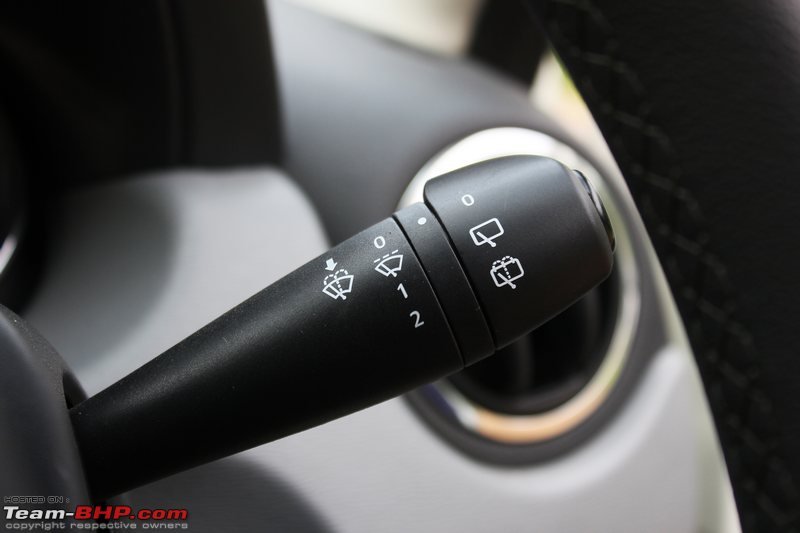 ...the only addition being this button on the right stalk. It's used for cycling through display items on the MID:  The stalks sure have a rudimentary movement. Feels like the joints are jammed at times:  Still no dead pedal. Despite how it looks in the picture, there isn't enough place next to the clutch to slide your foot through:  Leather-wrapped gear knob is new. Feels nice to hold. Collar needs to be lifted to engage reverse:  MediaNav system includes radio, media (USB & Aux), Bluetooth hands-free telephony, GPS navigation and a 'Dark mode' to dim the screen:  The interface is basic, yet the buttons are conveniently large and easy to use in a moving car:  Inbuilt GPS works well. Useful for keeping your bearings if you go off the beaten path:  When the system is off, or the screen is in 'Dark Mode', a classy looking clock is shown:  The hazard lights button has been made smaller, while the central locking button is now a more convenient toggle with an inbuilt LED:  This 3-way switch lets you choose between activating Cruise Control (left), setting the max speed-limiter (right) and switching both of them off (center):  Air-conditioning controls are identical, though the rear defogger button has been moved down here. Shockingly, no climate control offered in a car that can cost Rs. 15 lakh on the road!  Seat upholstery has been revamped to a grey & burnt-red colour scheme:  The fabric seems very durable. Parts of the seat have a raised honeycomb pattern:  Seat height adjustment is via the same ol' exposed piece of metal. You don't crank it, but instead hold it while you manually raise / lower the seat   Door pads get a padded fabric area. Looks and feels nice. Unfortunately, the ledge where you rest your arm is rock hard:  Tacky plastic cap where the window switches should have been (on all 4 doors) is a major downer:  Rear door pads look nice. No storage. Window switch is poorly located where you'd rest your elbow, instead of the patched-up location ahead: 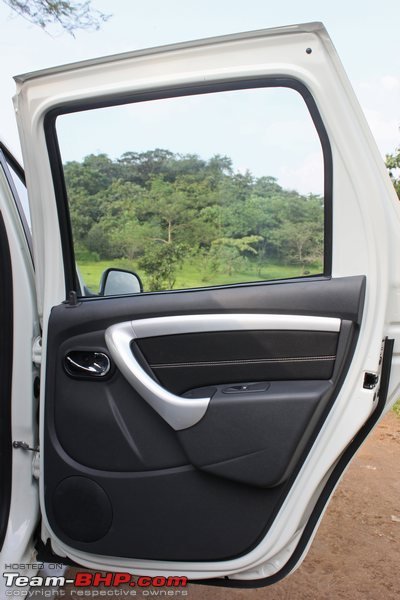 Mediocre legroom for rear passengers. Seat offers superb support and the backrest is nicely reclined for comfort:  At a reduced 410 liters, the boot still has tons of space. Main difference is that the flooring has been moved up by 2 inches to the height of the lip. This actually makes the boot easier to load / unload. Note that the spare wheel is now housed within the boot (2WD has it mounted below the car):  Last edited by Rehaan : 20th October 2014 at 23:46. |
| |  (25)
Thanks (25)
Thanks
|
| The following 25 BHPians Thank Rehaan for this useful post: | aah78, Aditya, carrazy, DriveTrain, ex670c, Gannu_1, GTO, hmansari, InControl, MaheshY1, RavenAvi, rednikhil, rshanker, S2!!!, Sheel, Simhi, Simple_car, SmartCat, swiftnfurious, Technocrat, Tejas@perioimpl, theexperthand, TOINGPOING, vb-saan, yosbert |
| | #5 |
| Team-BHP Support  Join Date: Feb 2004 Location: Bombay
Posts: 24,198
Thanked: 36,139 Times
| Engine & Driving Experience 1.5L dCi engine with 109 BHP & 245 Nm peak torque. The AWD media cars didn't have the engine cover of the 2WD variant:  The Duster AWD shares its 1.5 liter diesel 'dCi' engine with the 110 PS Duster 2WD. There's no 85 PS engine offered with the AWD layout. Despite sharing the same engine, there are 4 changes in the AWD's setup that make it a significantly different experience to drive. Firstly, the engine is in a different state of tune. The AWD puts out 109 BHP @ 4000 rpm, while the Duster 2WD puts out the same power at 3900 rpm instead. Despite the power peak shifting up the revv range, the peak torque has done the opposite and moved 500 rpm lower down! Torque has also dropped by 3 Nm, resulting in 245 Nm of torque @ 1750 rpm on the AWD (instead of the 2WD's 248 Nm @ 2250 rpm). As you'll see, what looks like a minor difference on paper turns out to be a very noticeable & welcome change in reality. Importantly, torque lower down the revv range is preferred in offroad applications. The second difference is that the AWD's 6-speed gearbox has shorter gear ratios. This means that you'll get snappier in-gear acceleration with the Duster AWD (compared to the same gear on the 2WD sister). This enables you to shift into higher gears earlier. Of course, it also means that, in some high-rpm situations, you'll be forced to upshift earlier in the AWD. The 3rd major mechanical change is the independent rear suspension and the 4th is the AWD drivetrain. The engine & gearbox differences transform the driving personality of the Duster AWD. That infamous turbo-lag is virtually gone! The Duster AWD is incredibly driveable. Forget offroad, this is better in the city than the 2WD. We found ourselves pulling away from 25 km/h slowdowns in 3rd gear without a fuss. No vibrations, no knocking...the engine just obliged. On inclines tackled at low rpms, there was no bogging down. Even on the highway, there's no need to spool up into turbo-friendly rpms before an overtaking manoeuvre. Just put your foot down, and the power comes in smooth and early. The engine feels extremely malleable; thanks to the short gearing, you rarely feel the need to move your hand over to the gearlever for a downshift. Yes, there is an additional bit of zip when the turbo gets into its zone, but it's not even close to being a laggard below that point. If it wasn't for the known weak spot of the 110PS Duster, turbo-lag wouldn't even be something that comes to mind with the AWD variant! When it comes to power, reaching high speeds isn't an issue with 109 horses under the hood. Especially in 6th gear where the engine isn't making too much noise, it's easy to relax your right leg and unintentionally end up crossing the 120 km/h mark. One interesting thing we noticed was that the accelerator travel feels like it ends at a certain point. It actually doesn't. If you push your right foot down a bit harder, the accelerator goes a noticeable bit further (just like a kick-down in an automatic car). This results in a little more acceleration on the Duster. The Duster has long legs and has the capability to be an able long distance tourer. When the Duster was introduced in 2012, it had an extremely heavy clutch pedal. Renault did revise this later in the production cycle to make things more manageable. The AWD's clutch pedal is user-friendly. It's certainly not feather light, but it's not heavy either. This would be an average weighted clutch in a typical sedan (suffice to say my Vento TDI's clutch is heavier). The clutch pedal travel range is middle-of-the-way too. The 6-speed gearbox isn't the smoothest or most well-defined units around. It does require some effort to engage gears at times, and shifting across columns (e.g. 4th to 5th) requires that you pull the lever towards yourself consciously. That said, we didn't encounter any mis-shifts, and those of you who love driving manual transmissions will enjoy the shorter ratios and ability to jump up the gears quickly. There were several times where we were only at 50 km/h, yet already in 5th or 6th gear! The dCi engine redlines at 5000 - 5100 rpm (it isn't marked on the tacho). To illustrate the shorter gearing, here's the max speed in each ratio: 1st gear max speed: 30 km/h 2nd gear max speed: 52 km/h 3rd gear max speed: 83 km/h 4th gear max speed: 120 km/h Here's the cruising speeds with their corresponding rpm levels: 5th gear at 100 km/h: 3100 rpm 6th gear at 100 km/h: 2300 rpm 6th gear at 120 km/h: 2800 rpm The Duster AWD has an electro-hydraulic power steering. At parking speeds, the steering is quite heavy. It's certainly not 1-finger light, but at the same time, it's not heavy enough for most drivers to complain about it. Once you speed up, the steering plays a big part in giving the Duster an incredibly planted & stable feel, including at triple digit speeds. The steering isn't at all twitchy on-center. Steering inputs do require a certain amount of force though, without which the Duster will just stay on course, dead-straight. Something that might be an irritant to drivers (especially with the AWD on rough roads) is the amount of feedback the steering gives you. If a single wheel hits a bump, you feel a slight tug on the steering. There were high frequency vibrations coming through onto the steering wheel too. This can be felt even on cemented roads like the Mumbai-Pune Expressway, and leads to some amount of driver fatigue. Over long journeys, combine that with the Duster's unimpressive NVH insulation. Inside the cabin, the Duster AWD's noise insulation falls short. There's an audible low-frequency drone from the engine that starts between 2,000 & 3,000 rpm. Even when you lift off the accelerator (say, at 60 km/h in 3rd), this noise persists during deceleration. The engine becomes noticeably coarser as you approach 4,000 rpm. Past 4,500 rpm, mild vibrations become noticeable, and are even felt by the front passenger on his part of the floor. Having a 6th gear helps with reducing engine noise at high speed (due to lower rpms); however, tyre noise remains prominent. Post 100 km/h, wind noise is very noticeable around the A-pillar area and the top edges of the front windows. Everyone sings praises of the 2WD Duster's ride quality. Terms like 'hovercraft' and 'magic carpet' are used often. The AWD is no different in this respect. In fact, it's better! Due to the AWD's need for drive shafts to the rear wheels, the rear suspension has been changed from a "cost effective" torsion beam to a better performing independent multi-link setup. While it's not a night and day improvement over the 2WD Duster, there are certain situations where this setup has an advantage. As an example, when the rear wheels hit bumps at different times. In these conditions, the 2WD's torsion beam will have a tendency to create a slightly more side to side rolling motion at the rear of the car. The independent rear suspension tackles these typical pothole situations with less wind-up and therefore, less of the resultant body movement. That said, just to keep your expectations realistic, some high-frequency bumps and vibrations do come through (e.g. expansion joints on the expressway, rough surfaced roads), though medium and large bumps are smoothened out incredibly well. Even on bumpy dirt roads, you can comfortably exceed the speed at which you'd normally go in any other vehicle. Overall, the Duster's ride quality package is fabulous, and the AWD's rear suspension lends itself to further improving it. When it comes to handling, not much has changed. The Duster AWD is still solid on the highway (heavier steering helps too) and very car-like to drive. Though in most cases you'd never complain about the minor body roll, I just want to mention that it is present in small measure. High speed lane changes (100/120 km/h) do see the bonnet line disagreeing with the horizon a bit, but in no way is it scary. The Duster's dynamics are significantly superior to the likes of the Scorpio / Safari, and the Renault will run rings around them. The Electronic Stability Program (ESP), Anti-Slip Regulation (ASR) and Understeer Control work in the background to keep you going where you're pointing. We didn't see these systems activate on-road, but they did kick in quite often when we took the Duster AWD off-road. The brakes of the AWD are very nice. They aren't over-servoed (over-eager to bite), and the pedal isn't spongy at all. Brake Assist (BA), Electronic Brake-force Distribution (EBD) and Anti-Lock Braking System (ABS) are welcome safety features of the Duster. Brake modulation is easy, pedal feel is nice, braking is confidence inspiring and the car stops dead straight. Renault has given the Duster AWD 'Hill Start Assist' too. Basically, if you're starting off on an ascent, the vehicle won't roll back for 2 seconds after you release the brake pedal. This gives you enough time to release the clutch and accelerate. The Duster AWD is equipped with Cruise Control, a speed-limit feature and an ECO mode. A button on the center console lets you choose between activating either the Cruise Control or the Speed-limit feature. Cruise Control works well, as expected. The driving speed can be raised or lowered in 2 km/h increments, which is convenient. The same applies for the speed-limit feature which doesn't let you accelerate beyond the max speed you've set. Note that this feature is more for helping the driver obey speed limits, as it is easy to activate, adjust and deactivate. It isn't like the more discreet "valet mode" speed-limit setting that is found on a few other cars. Pressing the ECO mode button lights up a green 'ECO' sign on the instrument cluster. There's not a very perceivable difference, it just feels like the turbo isn't spinning up all the way to as high an rpm as it normally would. Performance in this mode doesn't feel crippling at all. ECO mode is very usable for city driving and fine for highway runs too, if you're just cruising (as opposed to a lot of overtaking and speed variations). Renault claims that fuel consumption will be 10% less when ECO mode is activated. ARAI tests show the Duster AWD at 19.72 kpl (the Duster 2WD 110PS is rated at 19.01 kpl). That's almost 1 kpl higher FE, despite the 93 kilo additional weight of the AWD Duster. The engine tuning and perhaps, the shorter gear ratios, are responsible for altering the results of the ARAI's synthetic test. In our short offroad run, the Duster AWD returned 10.2 kpl (with a fair amount of fast driving & idling). On the expressway run, the AWD delivered 15.4 kpl. The AWD Duster has the same 50 liter fuel tank, making it extremely convenient for long distance trips. The 'ESP Off' and ECO mode buttons are placed on the center console, beside the 12v socket & drive mode selector: 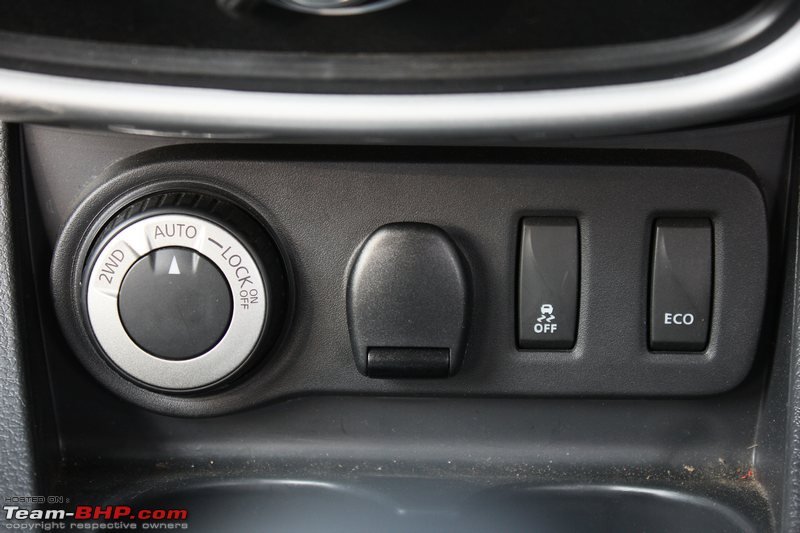 This gearshift icon lights up to suggest an upshift or downshift:  When ECO mode is activated, a green "ECO" sign shows up on the speedometer:  'ESP Off' has an indicator above the MID:  The preset speed displays here, whenever 'Cruise Control' is activated:  Likewise, the speed-limit function has its own icon, with the set maximum speed showing on the MID:  29 PSI recommended all around, regardless of whether it's for the highway or not:  Last edited by Rehaan : 20th October 2014 at 23:47. |
| |  (29)
Thanks (29)
Thanks
|
| The following 29 BHPians Thank Rehaan for this useful post: | Aditya, Akshay1234, ampere, anilntny, carrazy, DirtyDan, Dr.AD, Gannu_1, GTO, hmansari, InControl, Insearch, lurker, MaheshY1, planet_rocker, RavenAvi, rednikhil, Roy.S, rshanker, rxpaul, S2!!!, scopriobharath, Sheel, SmartCat, swiftnfurious, Tejas@perioimpl, theexperthand, vb-saan, yosbert |
| | #6 |
| Team-BHP Support  Join Date: Feb 2004 Location: Bombay
Posts: 24,198
Thanked: 36,139 Times
| Re: Renault Duster AWD : Official Review 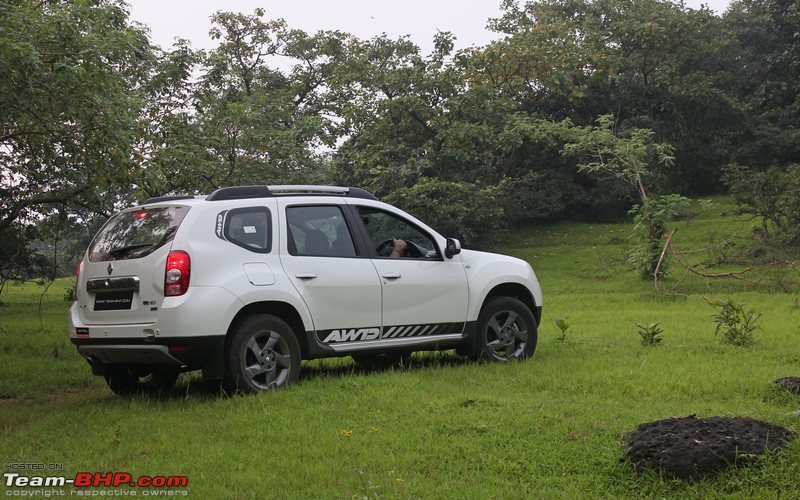 We should start by clarifying that the Duster isn't a hardcore offroader like the Jeep & Gypsy 4x4s, and shouldn't be confused as one either. Having said that, the Duster AWD can 'green lane' and is a very competent softroader. It's got wonderful ground clearance and approach, departure & ramp angles. The wheels are placed at the far ends of the vehicle. Turbo-lag has been nearly eliminated and the gearing is shorter too. This Renault is substantially lighter & smaller than most body-on-frame SUVs, giving it a certain agility in the rough. All of these factors contribute to making the Duster capable of handling the needs of 95% of its target market. It's no rock crawler, yet the Duster has adequate talent to tackle inexistent roads, muck, slush, sand, snow and the greens. We tested the Duster with OEM MRF Wanderer road tyres. A set of all-terrain tyres would dramatically step-up its offroad skills. The drive mode selector. "4WD Lock" is a spring loaded toggle. Turn it once to activate, and again to deactivate:  The AWD system has 3 electronically switchable modes: 2WD - Vehicle drives in FWD mode (like the regular 2WD Duster). 4WD Lock - Power is sent to all 4 wheels by permanently engaging the rear wheels. Applicable to a max speed of ~50 kph. Renault recommends selecting this mode only when offroading. Auto - Automatically sends power to the rear wheels only when the system feels it's required. Otherwise, the vehicle continues in FWD mode. For the most part, the Auto setting does a great job of managing the choice of how many wheels to power. Note: 2WD & 4WD modes are indicated on the instrument cluster. Auto mode has no such indicator. Jeepers that expect a wall of torque to hit them when shifting to 4WD will be disappointed, since there's no low ratio box present. As if to compensate for this, 1st gear has been made rather short (topping out at 30 km/h); as a result, the crawl torque isn't bad. The Duster AWD will lug itself uphill and over small obstacles without much accelerator input. The downside of this however is that, in some extreme situations (e.g. rock crawling), the crawl rate is a bit too fast, and you have to tap the brakes to slow down. At the same time, you might have to slip the clutch to counteract the ECU's anti-stall function (which automatically adds some undesired throttle in these conditions). This becomes an unnecessary shuffle at times. Be careful not to overheat or burn your clutch in such situations. The Duster AWD can crawl grassy, wet mild slopes all day long without a hiccup. Though we didn't test the performance on long climbs, Tejas was sure that the Duster has enough grunt for these runs, especially with the Traction Control system lending a helping hand when needed. The 'Hill Start' feature can prove useful if you stop midway and need to resume the climb. Moderator Tsk1979 recently spent several days with the Dacia Duster AWD in Iceland (related post (Renault Duster AWD launched at Rs. 11.89 lakh (pg. 15))). After crossing thousands of snowy kilometers, 3 rivers and 5 major water crossings, in his opinion, the Duster beats the Safari 4x4 (which he owns) and the Scorpio 4x4 on ice, snow and slush. The body-on-frame SUVs have an advantage in ground clearance though, despite their lower GC figure on paper (mostly due to the placement of the rear differential). A monocoque typically has lower-placed underbody components than a body-on-frame design would. The ESP / Traction Control is sensitive and kicks in frequently (which is a good thing in our view). It brings in more control and helps a lot on slippery surfaces. The ESP / TC acts similarly to an electronic diff-lock here, by applying the brakes to a slipping wheel and thereby transferring more power to the wheel on the same axle with more traction. This system gives the Duster AWD an advantage over the other 4WD SUVs in this price bracket (since they don't have ESP or lockable diffs). If you don't like the loud clicking of the system as it works, or prefer to do things the difficult way, there is an 'ESP Off' button on the center console. On rough country roads, the Duster is in its element and truly shines. You get more confidence on loose gravel, thanks to the ESP. The chassis is well-balanced, the engine is tractable and the brilliant suspension keeps the Duster planted on the road with negligible body roll. As mentioned in the previous post, the only annoying bit here are the vibrations that come through to the steering wheel. On rough roads, the rest of the car behaves brilliantly and you sit relaxed. But your hands get fatigued due to constant high-frequency vibrations being sent up through the steering column by the road surface. Tejas says that if he owned a Duster, he'd add a soft grip steering cover to damp out these vibrations. The driver's seat can be cranked up fairly high, thus lending the driver a good view of rocks & obstacles. The tight 5.2 meter turning radius is a boon when maneuvering between obstacles. Ground clearance stands at an impressive 210 mm (5 mm higher than the 2WD version). The Duster AWD's hanging exhaust is a hindrance to an otherwise flat & high underbody. It would probably be one of the first parts to get damaged by large rocks. On a related note, that bulky chrome exhaust tip interferes with the departure angle at its extremes. Yep, it can easily be removed. For a weekend warrior who heads out to the hills with the family, wants to picnic at a secluded spot or access the undeveloped plot of farmland he just bought, the Duster AWD is a great vehicle. Tejas points out that the Duster would be a competent rally car too and for all the travel bugs, it would do the likes of the Ladakh circuit comfortably. In fact, if on road & offroad ride comfort + capability are the main considerations, it's hard to think of a better AWD vehicle anywhere near this price-point. The Duster has superior on road manners to the body-on-frame UVs and its suspension keeps occupants far more comfortable. This is a crucial advantage for long-distance tourers. Heading off the beaten path:  That 210 mm of ground clearance gives you more room to play with, when tackling offroad terrain at various angles: 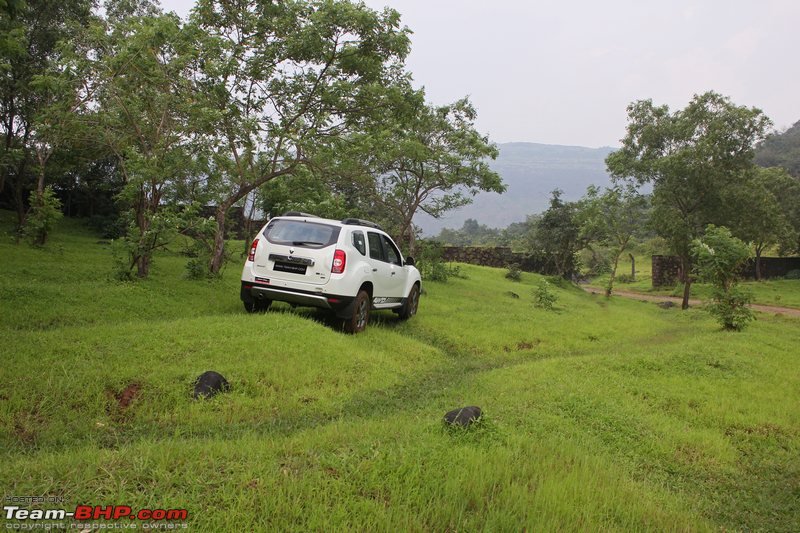 On such terrain, the Duster AWD can keep up with any other purpose-built 4x4. With far greater levels of comfort for the driver & occupants!  This brake cable was hanging loose and could have snagged. We clicked it back into place. Keep an eye on it when offroading: 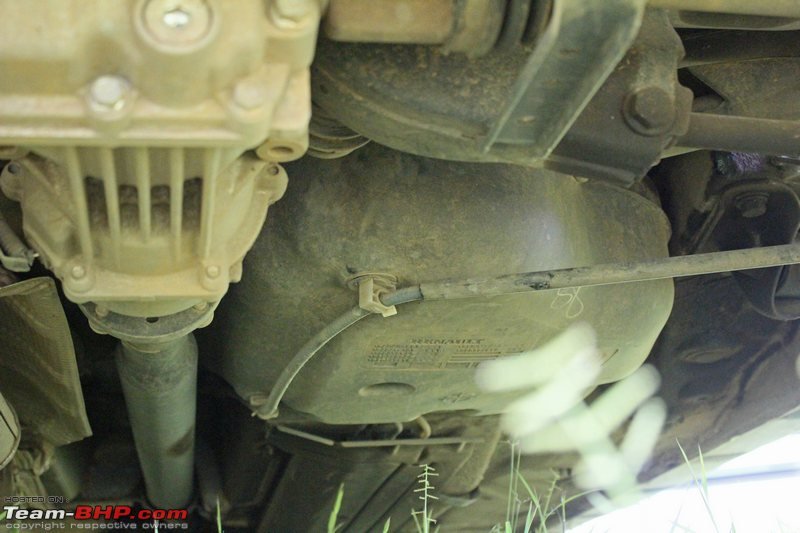 Because it had been raining, you can see how moist the surface is:  Slippery grass slope? No problem:  This patch had a couple of inches of very wet & slippery mud:  On sections like this, the ESP helps by using the power effectively, rather than wasting it on the spinning wheel/s:  Let's face it - this is probably the extent of offroading that an average Duster AWD owner would do:  Large rocks are the kind of obstacles you need to avoid. The high seating position and 5.2 meter turning radius are an advantage:  Obstacles that most tourers would encounter, like this tiny stream, are a non-issue for the Duster:  As expected, articulation is ordinary. Typical of a Duster-like vehicle:  The AWD is capable even with the stock MRF Wanderer on-road tyres. All-terrain rubber would take things to the next level:  A capture from Moderator Tsk1979's Icelandic adventure in the Dacia Duster AWD. He rented one for ~2 weeks: 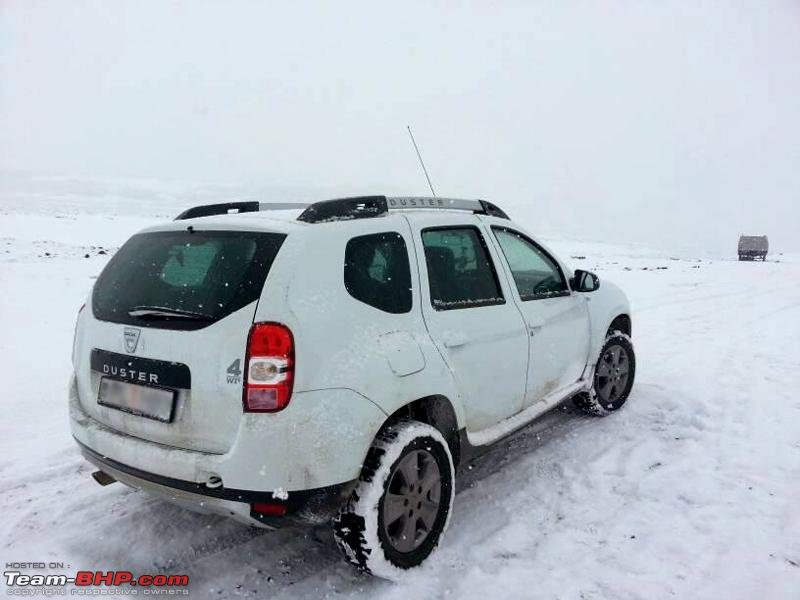 Last edited by Rehaan : 20th October 2014 at 23:47. |
| |  (35)
Thanks (35)
Thanks
|
| The following 35 BHPians Thank Rehaan for this useful post: | 9thsphinx, Aditya, Akshay1234, ampere, anandpadhye, anilntny, ARAY, carrazy, dean5545, Doge, ex670c, Gannu_1, Grr7, GTO, InControl, Insearch, Nash007, noopster, paragsachania, planet_rocker, RavenAvi, rednikhil, Roy.S, rshanker, S2!!!, scopriobharath, Sheel, shipnil, Simple_car, SmartCat, stormerider, swiftnfurious, Tejas@perioimpl, theexperthand, vb-saan |
| | #7 |
| Team-BHP Support  Join Date: Feb 2004 Location: Bombay
Posts: 24,198
Thanked: 36,139 Times
| Other Points Other Points: • Variant to variant, the price difference between the 2WD & AWD Dusters is 1.09 lakhs. The 2WD is already very pricey, yet we have to say that this 1.09 lakh AWD premium is completely worth it! It gets you the AWD, ESP, independent rear suspension, superior driveability & more ground clearance. Then, there's the smaller stuff like smoked headlamps, a better steering wheel, cruise control, speed-limiter etc. Usually, the AWD / 4x4 alone carries a Rs. 1 lakh premium (over the corresponding 2WD variant). Add a rupee value to all the additional goodies and the Duster AWD's 1 lakh extra comes across as a steal. • Unfortunately, India got the Duster AWD a full 2 years after the car's original launch. It's surprising it took this long, as the AWD has been manufactured & exported from India since 2012! • Sources at Nissan say there won't be a Terrano AWD for at least a year. • The Duster AWD sure has a lot of safety kit. However, it has received only 3 out of 5 stars in the Euro NCAP tests. • Thanks to the ESP's capability, you're less likely to get stuck. It's a USP for the Duster AWD in this price range. Other SUVs offering this feature are the more expensive XUV500 & Yeti. • Based on customer feedback, the protruding rear air-conditioner (image link) is no longer part of the standard equipment list. It's available as an option on the Duster 2WD, but not with the AWD. • Remember that elastic strap (image link) in the front passenger's footwell? It wasn't there on our AWD media car. • 4 year / 80,000 kms warranty is standard. This is amongst the best factory warranties offered in India. • A big shoutout to talented Moderator Stratos for post-processing the review pictures! AWD and 2WD compared side-by-side:   The new steering wheel and grey & black dashboard colour:   Updated 3-dial instrument cluster:  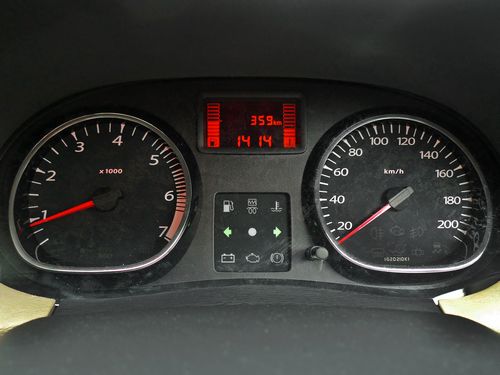 Last edited by Rehaan : 17th October 2014 at 18:16. |
| |  (39)
Thanks (39)
Thanks
|
| The following 39 BHPians Thank Rehaan for this useful post: | aaggoswami, Aditya, akshay81, anandpadhye, anilntny, Batfreak, Captain Slow, carrazy, dean5545, delta5, ecosport rules, frankmehta, gabrielthomas, Gannu_1, GTO, InControl, lamborghini, MaheshY1, mallumowgli, noopster, racer_ash, RavenAvi, rednikhil, rshanker, S2!!!, scopriobharath, sdp1975, Sheel, Simhi, Simple_car, swiftnfurious, Tejas@perioimpl, theexperthand, tsk1979, uday.ere, vb-saan, Vitruvius, Wanderers, yosbert |
| | #8 |
| Team-BHP Support  | 17 days, 5000kms with the Dacia duster 2013 We recently rented a Dacia duster AWD model 2013 for about 5000kms. The car was driven on tarmac, gravel, deep powdered snow, hard ice, rutted farm tracks and some rocky terrain. Also there were a few water crossings and 3 river crossings with water at bumper top level height. We spend 17 days with the vehicle, during which it was virtually our home, carry large suitcases, bags, camera gear, tripod and taking us to some far flung interiors of Iceland. Now the Duster is no Land cruiser, but what she could do was impressive. Actually more than I expected. Our vehicle came with almost the same features, and no climate control. However, our seats had back pockets and side pockets. The side pocket were net type, and you could fit a coke bottle 2L there. I do not see that on this one. Its such a wonderful feature. Getting to the vehicle itself, the cockpit was quite familiar. We have a Duster 2WD at home, and a Micra too. However, start the engine, slot the lovely gearshift into first, and release the clutch, and you realize this is a totally different Animal. The gearshift has 6 gears. Most six geared vehicles use this to go taller in order to get fuel efficiency. Duster uses this to go shorter. First gear is like Safari 2nd LOW. And the 6th? Well 100kmph comes at 2300rpm. This also means that you can comfortably shift to 5th at 50kmph. Infact, at 60, the shift indicator prompts you for 5th gear around this speed. 3rd gear is low speed traffic gear. First only if you are going real real slow. That said, the engine sounded pretty refined. There is a lot of roar, but its mostly tires. I attributed it to studded snow tires which have this real loud aircraft engine him, but reading the review, it appears to be a feature on the normal tire Indian dusters as well. From a driver and passenger POV, the dacia duster is a nice vehicle to drive and commandeer. The seating position is good, ample leg room, nice gearshift, everything within reach. The GPS console has a good night mode also, which darkens everything cutting glare. But its placed a bit low for my taste. Have to take eyes off sometimes. That said, the speech was more than adequate, first warning 800mts before an exit or turn, then 500mts, 300mts, 80 meters... and what not. Route recalculation is also pretty quick, and you can also give coordinates as destination. So standard stuff. But I guess, that is similar to 2WD duster too. Coming back to the driving, I must say this is much better on the road than the 2WD. The multi link suspension at the rear soaks up bumps pretty well. Handling is also very nice now, no doubt helped by TCS/ESP/EBD which I was too scared to switch off while doing 80kmph over terrifying gravel roads curving over the mountains. AS a dirt track warrior, the standard SUVs do not come close. This will annihilate the competition. I am told that there are kits for this engine to take it to 130bhp. In that case, the likes of Gypsy and XUV better watch out. This can be the next rally king. Move to tougher pastures, now lets talk about offroading. How is Duster as an offroad vehicle. Is it a mall warrior? Or is it something which you can take through a pothole without flinching? Expedition? Or offroading? Well to start with, on non undulating terrain like sand, snow, gravel and slush, our traditional ladder frame SUVs do not stand a chance. Even the likes of Thar can take a bow. With similar tires(tough, because I doubt you can buy 225/65, 215/70 or 215/65(stock) R16 sizes in A/T now), the duster will run rings around the open diff monsters. Its light weight will ensure no sinking, and TCS will ensure you are not spinning wheels uselessly, but putting power where its needed. Even if you need to do the three legged dance, which we had to because 40" tired monster trucks had totally destroyed the approach to a river, the duster shines. If you need to pull in some speed, no issues, she will stay in control, and even tell you how hard she is trying to prevent you from becoming part of the scenery by furiously blinking the traction control light. What about where you need to go slow. Well the 1st gear is pretty low. Not low range low, but maybe around 2nd gear low range. Infact, normal starts are best done in 2nd gear. Its like the crawl gear. Low gearing also means no turbo lag issues. Engine is also retuned, but then every bit helps. Other than that, we also noticed that while crossing rivers, no water came inside. The car doors had double sealing. Apart from standard seal/beading, even the external part of the door had rubber to prevent dust/water ingress. I dunno if the Indian AWD retains that. Iceland with its 80kmph ash winds is very unforgiving. Leave a tiny hole and you will have eyjafjallajokull inside. So have we found the ultimate offroader. Time to sell that Scorpio? Hold your horses. Not all is well. First the GC. Its only 210mm. Wait. Safari is 205? Well Safari center hump is 205. Most of the vehicle sits much above that. And you can scrape a diff over some ruts, no issues. Not with this baby. Look at the undercarriage pic. Everything sits at a lowish height. And you cannot scrape that exhaust. No problem in snow/slush, but rock crawling. Gotta be much more careful. AWD underpinnings are far more expensive to repair than a bent diff cover or a broken tie rod. This also creates a problem on rutted roads. High center rut can cause problems. Then the tire diameter is 27" as compared to 29.5 of the traditional ladder on frame. Every inch counts. The vehicle has underbody protection, but the front under bumper(intercooler?) + the rear AWD mechanism lack protection. I am told that the engine is protected by metal, but engine is not the only expensive thing here. Last but not the least, lets talk about air intake. Its high(right below bonnet), but faces the front(part of grill). This means, if you drive through deep water(lower than intake height) and just floor it, you are in trouble. Side air intakes like Safari are much better. They also allow for easier fitment of snorkels. Its not really low, but you have to be much more careful. To sum it up, she is the king of Gravel  Will happily play in snow, even snow has high as 10 inches. 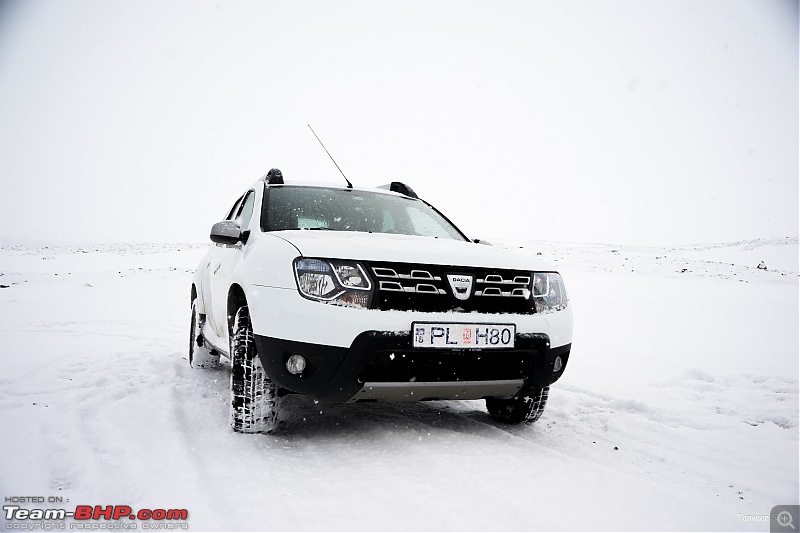 Will be good on ice too, albeit with the traction control light flickering angrily  On a good day you can even cross rivers, as other drivers just move sideways, letting you take the chance first 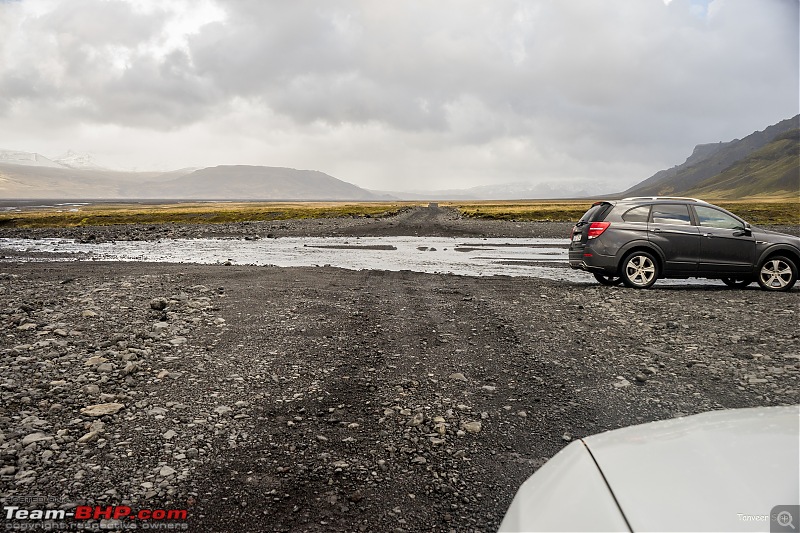 And with careful throttle input, you emerge victorious, wondering... HOW?  But.. be careful of ruts. There is no center diff to park sideways. You need to keep one wheel on the center, and often get down to check for sharp rocks hiding in the grass.  Here you go, I have said all I need to say. The review covers everything else and more. For those looking for their ladakh and Zanskar vehicle, go buy it. Those looking to do something a bit more adventrous fit 225/65(extra 7mm) or 215/70(extra 11mm) and you are all set. Those looking at lift kits, lift no more than 30mm, and make sure you go taller on tires. Wider tires will scrape even on lift kit. Proably 225/80 on a lift kit will be the perfect combo. Rallyist? What are you waiting for? But if you wanna do Palar challenge, mod a ladder on frame. The cost of damage on an AWD is too much. On a lighter note, for those of you like us, for whom airplane travel is a nightmare because travel light does not exist in the dictionary, do not worry... the spare wheel inside does not rob too much space. Just remove the parcel tray, and......  EDIT: Adding an in dash video of the Throsmork/Porsmork drive. Last edited by tsk1979 : 24th November 2014 at 09:45. |
| |  (65)
Thanks (65)
Thanks
|
| The following 65 BHPians Thank tsk1979 for this useful post: | .anshuman, 100kmph, 9thsphinx, abhinavinc, Akshay1234, amit_purohit20, anandpadhye, chiranjitp, docswarna26, Dr.AD, DrANTO, ex670c, Gannu_1, Grr7, InControl, Insearch, ishankpatel, itwasntme, katoom, kevintomin, kingofkings, kiren, krish3, lamborghini, mac187, maglev, MaheshY1, mallumowgli, MAS, megazoid, mohitk1993, navpreet318, neoonwheels, niv26, noopster, pratyaksh, pulsar56, racer_ash, rajesh1868, RavenAvi, razor4077, rednikhil, Rehaan, rehaan2, Reinhard, ron82x3, rshanker, rxpaul, S2!!!, Samurai, satvik4134, sdp1975, Sheel, shipnil, Simhi, SmartCat, spd_tkt, sridhar-v, starter, Technocrat, theexperthand, vb-saan, Vid6639, Vitruvius, Wanderers |
| | #9 |
| Team-BHP Support  | Re: Renault Duster AWD : Official Review Thread moved from the Assembly Line to Official Reviews. Thanks for sharing! Rating review a well-deserved 5 stars  |
| |  (2)
Thanks (2)
Thanks
|
| The following 2 BHPians Thank GTO for this useful post: | amit_purohit20, frankmehta |
| | #10 | ||
| Senior - BHPian Join Date: Mar 2010 Location: Bangalore
Posts: 1,614
Thanked: 2,204 Times
| Re: Other Points Quote:
 Yup the AWD is worth the 1.09 premium! But this again will go up once we add in road tax, insurance. Yup the AWD is worth the 1.09 premium! But this again will go up once we add in road tax, insurance.Rehaan, Just 1 question. I couldn't see the spare wheel hanging outside like the 2WD Duster. Does this mean that the AWD has a concealed spare wheel? Like a sedan ? Ah never mind just read it! - Quote:
Last edited by Captain Slow : 17th October 2014 at 18:25. | ||
| |  ()
Thanks ()
Thanks
|
| | #11 | |
| Team-BHP Support  | Re: Other Points Quote:
| |
| |  ()
Thanks ()
Thanks
|
| |
| | #12 |
| Senior - BHPian Join Date: May 2007 Location: Vadodara
Posts: 4,997
Thanked: 3,000 Times
| Re: Renault Duster AWD : Official Review The review is fantastic! And the images of taking car in wet grass is something one wouldn't expect in a Duster. But I really wonder how does the Duster AWD compare against XUV500 AWD. Price might be a bit different, but on the whole, XUV500 would have access to higher service centres and is an equally good car IMO. Did Renault, by any chance, display/discuss any sort of comparison possible between XUV500 AWD and Duster AWD ? I still cannot digest the fact that Duster is sold at a higher price and still based on old Micra Platform. NCAP rating, even with multiple airbags, are not confidence inspiring. But nevertheless, atleast we now have more options. Poor NVH as compared to even 2WD is not digestible given the price. Look at Hyundai, they are segment leaders in NVH. Did the noise change w.r.t road surface on stock tyres ? What is water wading depth, more or less than Ecosport ? Last edited by aaggoswami : 17th October 2014 at 18:42. |
| |  ()
Thanks ()
Thanks
|
| | #13 |
| BHPian Join Date: Jul 2013 Location: Dance Bar City!
Posts: 359
Thanked: 702 Times
| Re: Renault Duster AWD : Official Review Brilliant review @Rehaan. The little things you have found out in such short time is very well appreciated. I have one question for you though: I remember reading that you need a flatbed for towing AWD/4WD vehicles, and especially when in lock position. Does this apply to the Duster as well? Also, the nissan x-trail's manual clearly states that in case you cannot arrange for a flat bed pick up, you need to tow the car from behind. Assuming that the duster AWD shares the same system, can you kindly confirm this in the manual? If the above is true, can I request you kindly add this point somewhere? Thanks, Simple_car |
| |  ()
Thanks ()
Thanks
|
| | #14 |
| BHPian Join Date: Aug 2009 Location: Bangalore
Posts: 597
Thanked: 737 Times
| Re: Renault Duster AWD : Official Review 12.9 lacs exshowroom in delhi I guess would translate to about 16 lacs on road in a city like bangalore. This looks really over priced for what it offers. |
| |  ()
Thanks ()
Thanks
|
| | #15 |
| BHPian | Re: Renault Duster AWD : Official Review Is it just me or there are fellow bhpians who think 4wd variant would have looked better in Adventure style body kit? |
| |  (22)
Thanks (22)
Thanks
|
| The following 22 BHPians Thank Thilak29 for this useful post: | abhinavinc, Captain Slow, carrazy, Chethan B G, Dr.AD, DrANTO, Getafix, InControl, Kairalee, kiren, mallumowgli, rdhan, riturajsharma19, rxpaul, Sachin Rai Vaid, scopriobharath, spd_tkt, starter, Technocrat, vishy76, vvvinod, Yeldo |
 |




